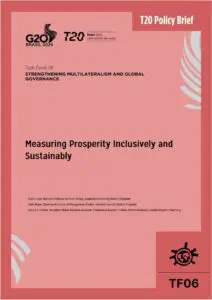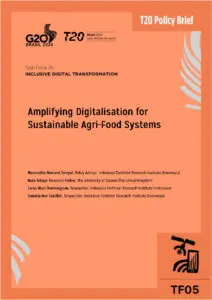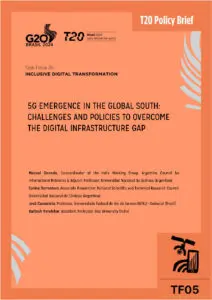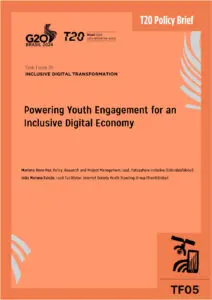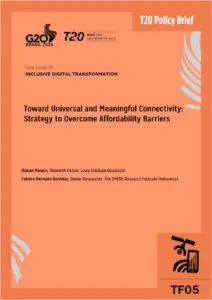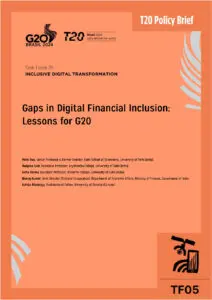There is a worldwide increase in forced migration induced by climate change and climate-related disasters. Policymakers need to take swift and decisive measures for tackling this impending global threat. One key challenge has been the reluctance in providing climate migrants the “refugee” status. This makes it difficult to address the issue under the existing multilateral and legal frameworks. Based on concrete measures, the G20 needs to become a proactive advocacy platform. It should develop the required definitions, norms, and regulations under the existing globally accepted multilateral frameworks to ensure planned relocations for both internally and externally displaced migrants.
Challenge
Currently, one of the acute consequences of climate change is the rise in both forced and voluntary environment-induced migration. The United Nations (UN) International Organization for Migration (IOM) predicts that climate change will likely generate at least 200 million to 1 billion migrants by 2050 (Bassetti 2019). In the following years, a person is more likely to be displaced due to natural disasters than wars (The Government Office for Science 2011). More than 140 million people (around 3% of the population of Sub-Saharan Africa, Latin America, and South Asia) may be forced to migrate within their countries by 2050 to escape the slow-onset effects of climate change (Riguad et al. 2018). However, tackling climate migration has been hampered by data and definitional issues. The number of climate migrants is difficult to confirm, but numbers are certainly underestimated. This is because causes of internal and external migration are complicated by the amalgam of complex social and economic issues that act as compounding factors (IOM 2008).
Another challenge is the incorporation of climate migrants into the definition of climate “refugees.” There have been heated debates in recent years on this topic, as the granting of refugee status to climate migrants would open doors to providing them with various benefits. Climate migrants have been acknowledged in various forms by multilateral institutions such as the European Union (EU) and the UN. However, no multilateral strategy or legal framework currently exists to account for climate change as a driver of migration (Podesta 2019). The Global Compact for Safe, Orderly, and Regular Migration, adopted by 64 countries, has called on nations to address the drivers of climate-induced migration and provide support to those forced to migrate.
Climate change, as a sole driver of migration, is tricky to define, making it difficult to identify migrants who qualify as climate refugees (ADB 2011). Migration due to environment-induced disasters often takes years to materialize and is not always forced. Such forms of migration may happen internally, which means local authorities (not international bodies) are responsible for providing support. More importantly, the UN’s refugee agency, UN High Commissioner for Refugees (UNHCR), is already stretched in providing support to the world’s 22.5 million recognized refugees (IOM 2017, 2018). Adding climate refugees to the foray would make mobilizing the necessary resources and funding difficult under the current political climate. A global migration synopsis is presented in Figure 1.
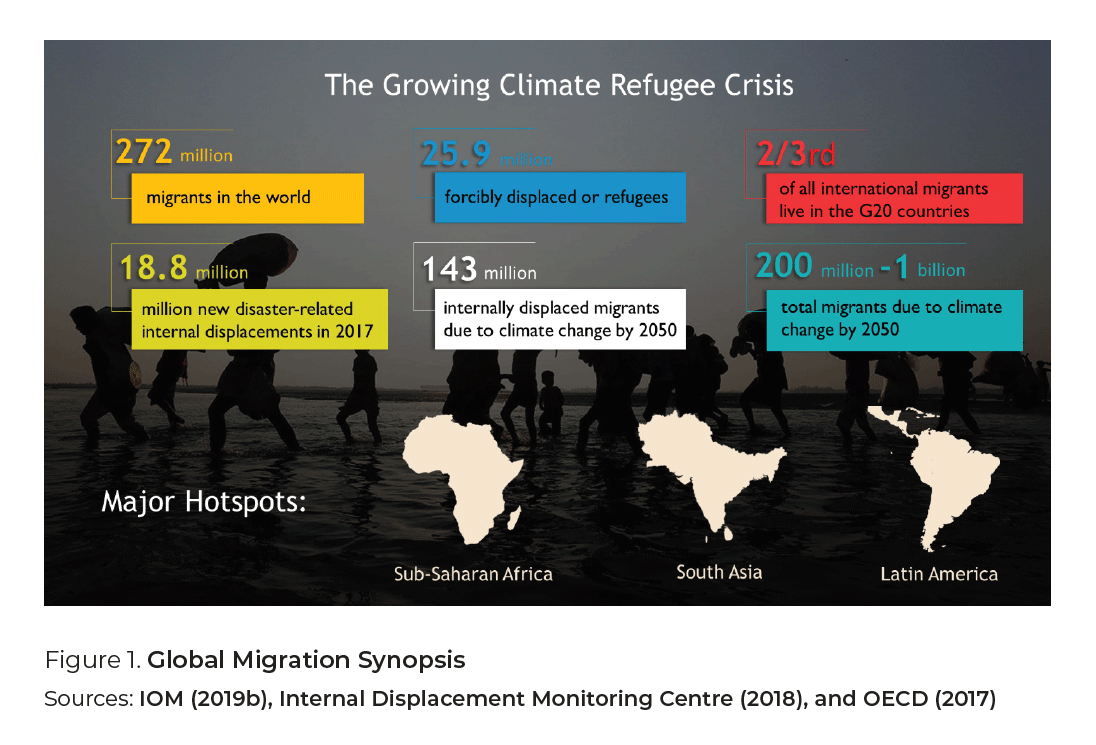
However, the UN Human Rights Committee’s acknowledgment that climate change can be a reason to seek asylum has been a positive point (UN 2020). While this decision is non-binding, it puts pressure on countries to consider climate-related asylum claims and opens the door to reinforcing this agenda in global forums such as the G20.
Proposal
Against these challenges, it is important that authorities such as the UN and EU provide climate migrants their due recognition as refugees. This will enable support from stakeholder organizations such as the UNHCR and others to mobilize financing and resources for these migrants (UNHCR 2017). This is a challenging agenda to accomplish. The key toward any agreement on definitions and norms at a multilateral level includes political and diplomatic impetus, which the G20 is well equipped to provide. This proposal falls in line with G20’s 2020 agenda of Empowering People, as we look to provide opportunities for underserved groups such as climate migrants (G20 2019).
The case for G20
Climate-induced migration poses a significant threat to G20 countries. In 2017, almost 8.5 million people were newly displaced by the sudden onset of disasters impacting G20 countries (OECD 2017). China, India, Indonesia, Japan, and the US account for most displacement in 2016–2018 (IOM 2019a). Climate and weather-related disasters represent the main drivers of these forced movements. For the world to tackle this crisis of climate change-induced forced migration effectively, the G20 needs to take a leading role in promoting and reinforcing feasible, realistic, and actionable measures under the existing multilateral frameworks.
The G20 is comprised of high carbon-emitting nations (78% of all greenhouse gas emissions were emitted by G20 nations in 2018) (Enerdata 2019). Thus, they bear responsibility in addressing the challenges of climate migration. G20 countries are also at the forefront of the latest climate adaptation technologies. Most of them have already made commitments to address environmental migration and disaster displacement through international migration and disaster and climate change policies. Therefore, G20 countries should play an essential role at the global, regional, and national levels in promoting policies and measures supporting disaster risk reduction and climate migration governance. In sum, these efforts can help prepare for and tackle environmental migration and disaster displacement, while also minimizing the climate change-related drivers of migration.
Recommendations
1. Developing definitions, norms, and regulations for climate migrants in the G20
The first step in addressing the issue of climate migrants is acknowledging the problem, which most multilateral conventions and authorities have done over the past decade. For example, the EU has, on various occasions, voiced concerns on climate-induced migration and called for global action to support climate migrants. In the Paris Agreement, the signatories requested that the Warsaw International Mechanism for Loss and Damage Associated with Climate Change (WIM) develop recommendations for people displaced due to climate-related issues. As a result, the Executive Committee of the WIM established a Task Force on Displacement in 2015 (UNFCC 2019), which has completed its first phase of implementation—to generate recommendations on displacement related to climate change.
However, relying solely on the United Nations Framework Convention on Climate Change (UNFCC) is not sufficient to address the issue of migrant displacement. Further, the UN’s refugee activities must ensure due support for migrants. The UN developed the Global Compact for Migration (GCC) to address this issue, but not in a legally binding fashion. It is thus necessary that the original 1951 Refugee Convention is amended to properly define climate migrants as refugees.
The G20 cannot directly administer such amendments. However, a consensus of the largest global economies on this issue and the subsequent support for identifying definitions, rights, rules, norms, and regulations will provide a much-needed impetus to bring about the necessary amendments to the 1951 Refugee Convention. While discussions on this issue have ensued for years, agreement on providing climate migrants refugee status has faced obstacles, given the challenges of identifying migrants whose movements have been induced by climate change. In this regard, the G20 needs to agree to support an UN-backed independent expert group. This group would analyze the existing challenges and develop definitions that can differentiate internal from external migrants and their treatment as refugees. The group will also determine the criteria for classifying them as climate refugees, and the subsequent benefits they may receive. Once the G20 reaches an agreement over the proposed solution, the G20’s collective diplomatic impetus needs to be leveraged to help ratify the amendment at the UN level.
2. Foster international protection for internally displaced migrants in the G20
Existing multilateral frameworks and conventions are set up in ways that hamstring the ability of multilateral institutions such as the UNHCR to support internally displaced migrants. As a result, such efforts are mostly confined to the national or regional levels. However, a major portion of climate migrants are internally displaced (McAdam 2017). This group of migrants thus has to rely on state or local support, which is often inadequate in afflicted regions. Therefore, the amendments to the definitions, norms, and regulations, as suggested in the first recommendation, need to incorporate the rights of internally displaced migrants as well. They must focus on how multilateral help—as received by cross-border refugees—can reach them. In this regard, the G20 needs to support the amendment to the 1951 Refugee Convention that establishes the normative and legal framework to incorporate internal migrants as part of the refugee population.
The UNHCR has already produced “Guidelines on Temporary Protection and Stay Arrangements” to inform governments on the possible responses to human movements engendering from humanitarian crises at the state-level (UNHCR 2014). However, national-level arrangements alone are not sufficient. There is a need for the international protection of internally displaced migrants. The G20 can thus serve as a policy discussion platform, as opposed to one that can develop and implement actionoriented solutions. The G20 needs to reach a collective diplomatic consensus in not only acknowledging the need for protection of internally displaced migrants, but also in charting ways to provide support through multilateral institutions. This consensus needs to be translated through the support of G20 nations during UN meetings and assemblies, where the issue of climate migrants is raised.
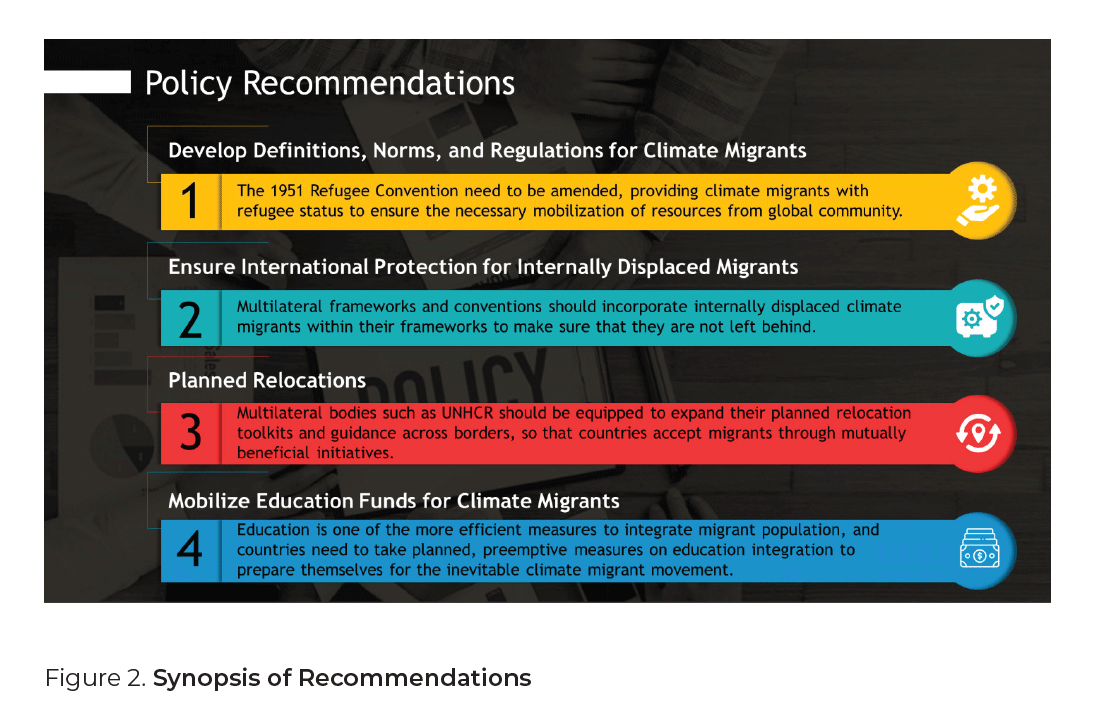
3. Planned relocations
Currently, there is no guidance or mandate that takes into account the planned relocation of cross-border migrants stemming from climate disasters and change. A planned relocation can be mutually beneficial for G20 nations. For example, many of these nations have aging populations and a surplus of jobs, both detrimental to the economy and the working population (ADBI 2019).
Before establishing a legally binding framework, countries need to reach an agreement that allows for planned relocations across states. The G20 should thus support the establishment of a framework and agreement under the UNHCR that guides the development of planned habitats for migrants. That way the burden of migration will not fall onto the shoulders of a few countries. Under the proposed framework, the G20 can come together and agree on sharing the burden of hosting displaced populations.
The G20 member states also need to organize expert panel discussions with the source countries of climate migrants to collectively agree on the criteria, conditions, and guidelines of the planned relocation and integration processes. In this regard, the G20 countries need to consider their individual contributions toward global climate change that can cause such migration. This is a contested issue that transcends
politics and diplomacy. It is imperative for the G20 to agree upon a framework set up by an independent expert group to clarify the contributions and the subsequent sharing of the burden of climate migrants, as well as the provision of development assistance. It is also important to consider the issue of refugee integration faced by many host nations in recent years during these discussions. Additionally, countries that are unable to provide asylum may compensate through, for example, additional funding, training facilities, and capacity building, to achieve the common goal of averting the crisis of climate migration.
4. Mobilizing education funds for climate migrants
As part of the rehabilitation process, one of the more efficient measures to integrate the migrant population into a host community is to invest in educational resources (European Commission 2018b). For climate migrants, there is a lack of international coordination toward the mobilization of sufficient funds, primarily due to their lack of refugee status. Compared to other forced migrants, climate migrants are left behind in terms of educational integration, which is typically a slow and often non-prioritized issue. The European Commission has supported the education and training programs of climate migrants in its member states through the Commission Action Plan on the integration of third-country nationals (European Commission, 2018a). However, developing and underdeveloped nations struggle to implement such measures due to their inability to mobilize available funds, which is often due to bureaucratic and governance issues. Hence, a concrete and accountable initiative is necessary for success.
As we prepare to integrate an increasing number of climate migrants into host communities, the G20 needs to reach an actionable consensus in using bilateral funds to provide education and develop skills. Such funds can also be channeled toward a dedicated fund, established under multilateral institutions, such as the UN Central Emergency Response Fund, UNHCR, and the World Food Programme. Under such an agreement, funds will be mobilized to set up schools and technical and vocational education and training institutions in host countries to equip the migrants with the skills necessary for employment. G20 leaders should thus commit to providing a higher proportion of national contributions in the form of multilateral support. Additionally, the G20 needs to use its political and economic leverage to encourage international organizations to scale-up their efforts to bolster education for displaced individuals.
Conclusion
Climate migration is one of the worst global disasters due to climate change and will significantly impact both developing and developed nations. By reaching an actionable consensus and identifying proper definitions for internal and external climate migrants, agreeing on planned relocations, and mobilizing education funds, the G20 can make a statement on tackling this global crisis. This approach will involve solving the definitional barrier currently hampering action on climate refugees internationally and making an effort for supporting existing national, regional, and multilateral mechanisms. Later, the G20 will likely be unable to cope with this crisis that will only increase with time, ultimately affecting billions of people. This challenge thus necessitates the development of a strong policy framework to assist climate refugees through labor market integration, education development, planned relocation, and regulatory streamlining.
Summary
The 1951 UN Refugee Convention, ratified by 145 states, is considered the manual for operations regarding refugees within universally accepted rules and regulations. However, this Convention needs to be modified to include climate migrants, so that they receive the same kinds of provisions that refugees currently receive. Additionally, both internally displaced and external climate migrants need to be recognized under this legally binding framework, so that multilateral institutions can equally focus their efforts on both groups. G20 nations, as drivers of global climate change, should agree to planned relocation models with the affected countries by considering their economic and social synergies. Post-relocation, G20 communities should agree on integrating these climate migrants under a common framework, as many G20 nations who have hosted refugees have already faced social backlash from host communities. Education of migrants needs to be the foremost priority during the integration phase, as studies have shown education to be the most efficient and costeffective rehabilitation tool for refugees. As such, the G20 needs to reach an actionable consensus in using bilateral funds to support education and skill development.
Disclaimer
This policy brief was developed and written by the authors and has undergone a peer review process. The views and opinions expressed in this policy brief are those of the authors and do not necessarily reflect the official policy or position of the authors’ organizations or the T20 Secretariat.
References
ADB. 2011. Climate Change and Migration in Asia and the Pacific. Development Report. Manila: Asian Development Bank.
ADBI. 2019. Aging Societies: Policies and Perspectives. Policy Report. Tokyo: Asian Development Bank Institute.
Bassetti, Francesco. 2019. Climate Foresight. https://www.climateforesight.eu/migrations/environmental-migrants-up-to-1-billion-by-2050.
Enerdata. 2019. CO2 emissions from fuel combustion. Enerdata.
European Commission. 2018a. “European Website on Integration.” Accessed May 3, 2020. https://ec.europa.eu/migrant-integration/main-menu/eus-work/archive/actions.
European Commission. 2018b. Integrating Students from Migrant Backgrounds into Schools in Europe: National Policies and Measures. Publications Office of the European Union. doi:10.2797/819077.
G20. 2019. Overview of Saudi Arabia’s 2020 G20 Presidency. Riyadh: G20.
Internal Displacement Monitoring Centre. 2018. Global Report on Internal
Displacement 2018. Internal Displacement Monitoring Centre.
IOM. 2008. Migration and Climate Change. Research Paper Series. Geneva:
International Organization for Migration.
IOM. 2017. World Migration Report 2018. Geneva: International Organization for Migration (IOM).
IOM. 2018. “Global Compact for Safe, Orderly & Regular Migration.” Marrakesh. Accessed April 4, 2020. https://refugeesmigrants.un.org/sites/default/files/180713_agreed_outcome_global_compact_for_migration.pdf.
IOM. 2019a. 2019 International Migration and Displacement Trends and Policies Report to the G20. International Organization for Migration (IOM).
IOM. 2019b. World Migration Report 2020. Geneva: International Organization for Migration (IOM).
McAdam, Jane. 2017. “Seven Reasons the UN Refugee Convention should Not Include ‘Climate Refugees’.” Accessed June 6, 2020. https://www.smh.com.au/opinion/seven-reasons-the-un-refugee-convention-should-not-include-climate-refugees-20170606-gwl8b4.html.
OECD. 2017. G20 Global Displacement And Migration Trends Report 2017. Organisation for Economic Co-operation and Development (OECD).
Podesta, John. 2019. ”The Climate Crisis, Migration, and Refugees.” Accessed April 3, 2020. https://www.brookings.edu/research/the-climate-crisis-migration-andrefugees.
Riguad, Kant Kumari, Alex de Sherbinin, Bryan Jones, Jonas Bergmann, Viviane Clement, Kayly Ober, Jacob Schewe, et al. 2018. “Groundswell: Preparing for Internal Climate Migration.” Washington, DC: World Bank. Accessed March 15, 2020. https://openknowledge.worldbank.org/handle/10986/29461.
The Government Office for Science, London. 2011. “Foresight: Migration and
Global Environmental Change. Final Project Report.” London: The Government Office for Science. Accessed March 16, 2020. https://assets.publishing.service.gov.uk/government/uploads/system/uploads/attachment_data/file/287717/11-1116-migration-and-global-environmental-change.pdf.
UN. 2020. “UN News.” Accessed March 15, 2020. https://news.un.org/en/story/2020/01/ 1055671.
UNFCC. 2019. “Report of the Conference of the Parties on its Twenty-Fourth Session.” United Nations Framework Convention on Climate Change. Accessed March 15, 2020. https://unfccc.int/sites/default/files/resource/10a1.pdf.
UNHCR. 2014. Guidelines on Temporary Protection or Stay Arrangements. United Nations High Commissioner for Refugees.
UNHCR. 2017. “Towards a Global Compact on Refugees.” Accessed March 16, 2020. https://www.unhcr.org/59dc8f317.pdf.



